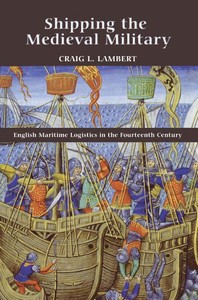Craig Lambert
Shipping the Medieval Military
Boydell Press, 2011. 256 pp. $90.00 USD. ISBN 978-1843836544.

A perusal of the Cumulative Bibliography of Medieval Military History and Technology, its updates, the International Medieval Bibliography and other military history bibliographies will demonstrate that despite the massive scholarship dealing with fourteenth-century warfare, logistical studies are still fairly underrepresented. Even those that do exist do not cover the topic evenly. In his historiographical introduction to Shipping the Medieval Military, Craig Lambert clearly points out the trend of recent logistical studies to focus heavily on land-based operations, and indicates that even maritime studies hitherto have concentrated largely on boats, ports and fleet operations. Lambert hopes his investigation will offer some insight into the naval contributions to the logistics of war supplying under Edward II and Edward III. His contribution, therefore, is a most welcome addition.
Lambert’s book is organized into four main chapters comprising the details of raising, outfitting and transporting supplies and armies by sea, as well as the resources necessary for successful maritime expeditions such as crew and ports. Within each chapter, Lambert delves into the essential questions pertaining to procedure, chronology, and developments or changes over time. He stresses repeatedly that which is true also of land-based endeavors: naval logistics were well-organized, highly efficient procedures. Lambert easily supports these claims, largely through statistical or anecdotal evidence from diverse primary sources. It is especially within the second chapter, on supplying armies and garrisons, that Lambert often helpfully provides information in table form. While not limited to this chapter, the tables here are particularly illuminating given the propensity for statistics and quantitative data, discussions of which are then well integrated into the text. The only oddity is the irregular nature of citations for the information compiled in the tables; in some cases there is no note whatsoever, whereas in others a detailed listing of sources, often manuscript, is provided. Following the text are two appendixes, one a listing by county of all the ports that supplied ships, and the other a description of the methodology used for identifying and calculating the size and composition of fleets. The former is perhaps the more helpful of the two, particularly for cultivating an appreciation of the geographically diverse and yet uneven nature of the ports’ military contributions.
One of Lambert’s greatest strengths is his obvious command of the vast corpus of both primary and secondary sources that touch this area of investigation. As such, his ability to contextualize his arguments within the historiographical framework appears effortless and the condensed historiographical discussion in the introduction is expanded and carried throughout the text.
The only significant critique has to do with the time frame of the book. The author has chosen a span of 1320-60, the terminus ante quem of which is fairly self-explanatory, as it marks the end of a successful and aggressive English effort in France that would soon be followed by the Treaty of Bretigny and a multiple year respite from formal warfare between the two realms. The choice of terminus post quam, however, is not as self-evident, especially if the book is designed to investigate the reign of Edward II as well as Edward III, which the author purports to do. Indeed, this starting point feels somewhat arbitrary, and lacks any real explanation or justification for the choice. Why not also discuss Edward II’s ill-fated Bannockburn campaign of 1314, which, if purveyance records can indicate, certainly must have had naval logistical support on a scale to rival other campaigns in Edward’s reign? This reviewer was left somewhat puzzled.
On the whole, Shipping the Medieval Military successfully achieves its goal of providing a fresh angle from which to explore the logistical side of warfare, demonstrating the central role naval operations played in Edwardian military ventures. Lambert has produced an extensively researched, well-written study that supplements and updates the body of logistics scholarship. Beyond being an excellent work in its own right, perhaps it is also a valuable warning to those of us engaged in the study of medieval military logistics that we must never overlook the naval angle, but rather integrate it into our investigations if we are to understand the entire picture.
Ilana Krug
York College of Pennsylvania <ikrug @ ycp.edu>
